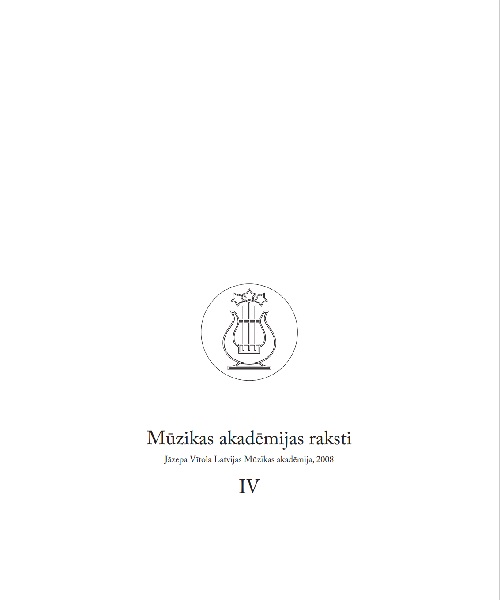THE FACTOR OF THE 19TH CENTURY ROMANTICISM IN THE GENESIS OF LATVIAN SYMPHONY MUSIC AND IN THE FIRST PERIOD OF ITS STYLISTIC DEVELOPMENT
Keywords:
Symphonic music, national romanticismAbstract
This article focuses on the problem, concerning the long-lasting influence of the style and aesthetics of the 19th century romanticism on the history of Latvian symphony music within 1880–1940. The above period witnesses the prevalence of the so-called national romanticism as one of the features of the 19th century romantic art in diverse symphony music by Latvian composers alongside with instrumental chamber music, choral works and operas. The most outstanding symphony pieces by composers of different generations (Jurjānu Andrejs, Jāzeps Vītols, Emilis Melngailis, Alfrēds Kalniņš, Jāzeps Mediņš, Jēkabs Mediņš, Jānis Mediņš, Ādolfs Ābele, Jānis Kalniņš, Volfgangs Dārziņš, Ādolfs Skulte, Jānis Ivanovs) mostly represent such genres as programmatic poems, illustrative music and suites. Most of Latvian composers, striving to be more or less original in their music, had adopted both the aesthetically elaborated principles of tonal harmony, homophone and poliphone texture by foreign composers of the 19th century, mostly French, Russian or German, as well as the notions of music dramaturgy and form. They also borrowed the intonation codes inherent to such music, making it possible to recognize their either formal or at the same time also deeply contextual identity, pertaining to one aspect of romantic style, namely, basic notions of the aesthetics of national romanticism. However, we find almost no traces of the branch of aesthetics and style of romanticism which reflects sharp contrasts, grotesque and dramatic pathetics within the context of music imagery. Such tendencies turn up mostly in the thirties and in the forties of the 20th century. Best examples of symphony music of the time are the following: the Second (Romantic) symphony (1938) by Pēteris Barisons and the Fourth symphony Atlantis (1941) by Jānis Ivanovs.
Downloads
References
Berelis, Guntis. Latviešu literatūras vēsture. No pirmajiem rakstiem līdz 1999. gadam. Rīga: Zvaigzne ABC, 1999.
Čaupova, Ruta. Romantiskas uztveres aspekti latviešu literatūrā un mākslā 20. gs. sākumposmā // Romantisms un neoromantisms Latvijas mākslā / Sast. Elita Grosmane, galv. red. Astrīda Iltnere. Rīga: AGB, 1998, 170.–177. lpp.
Goluba, Guna. Baumaņu Kārlis. Rīga: Liesma, 1990.
Grāvītis, Oļģerts. Arvīds Žilinskis. Rīga: Liesma, 1971.
Kačalova, Tatjana. Dažas pārdomas par neoromantismu // Romantisms un neoromantisms Latvijas mākslā / Sast. Elita Grosmane, galv. red. Astrīda Iltnere. Rīga: AGB, 1998, 124.–127. lpp.
Kārkliņš, Ludvigs. Simfoniskā mūzika Latvijā. Rīga: Liesma, 1990.
Klotiņš, Arnolds. Alfrēds Kalniņš. Rīga: Zinātne, 1979.
Klotiņš, Arnolds. Emīla Dārziņa estētika // Klotiņš, Arnolds. Mūzika un idejas. Rīga: Liesma, 1987, 5.–53. lpp.
Kļaviņš, Eduards. Neoromantisma pazīmes Latvijas 19. gs. beigu – 20. gs. sākuma tēlotājā mākslā // Romantisms un neoromantisms Latvijas mākslā / Sast. Elita Grosmane, galv. red. Astrīda Iltnere. Rīga: AGB, 1998, 116.–123. lpp.
Knepler, Georg. Musikgeschichte des XIX Jahrhunderts. Berlin: Henschelverlag, 1961.
Kučinska, Veronika. Romantisma iestrāvojumi latviešu lietišķajā mākslā // Romantisms un neoromantisms Latvijas mākslā / Sast. Elita Grosmane, galv. red. Astrīda Iltnere. Rīga: AGB, 1998, 162.–169. lpp.
Latviešu literatūras vēsture: 1. sēj. (No rakstītā vārda sākumiem līdz 1918. gadam) / Autoru kolektīvs; zin. vad. Viktors Hausmanis. Rīga: Zvaigzne ABC, 1998.
Latviešu literatūras vēsture: 2. sēj. (1918 –1945) / Autoru kolektīvs; zin. vad. Viktors Hausmanis. Rīga: Zvaigzne ABC, 1999.
Lukašinska, Inta. Ādolfs Skulte. Rīga: Liesma, 1987.
Mūrniece, Laima. Jāzeps Mediņš. Rīga: Liesma, 1977.
Muške, Vija. Jāzeps Vītols – mūzikas kritiķis. Rīga: Zinātne, 1974.
Pelše, Stella. Latviešu mākslas teorijas vēsture. Mākslas definīcijas valdošo laikmeta ideju kontekstā (1900–1940) / Disertācijas kopsavilkums. Rīga: Latvijas Mākslas akadēmija, 2004.
Samson, Jim. Romanticism // The New Grove Dictionary of Music and Musicians / Second Edition. Edited by Stanley Sadie. Executive Editor John Tyrrell. Volume 21. London: Macmillan Publishers Limited, 2001, pp. 596–603.
Stumbre, Silvija. Zvaigznes un zeme. Lūcija Garūta dzīves un daiļrades gaitā. Rīga: Liesma, 1969.
Stumbre, Silvija. Vasaras pastorāles. Komponiste Paula Līcīte dzīvē un darbā. Rīga: Liesma, 1985.
Tabūns, Broņislavs. Modernisma virzieni latviešu literatūrā. Rīga: Zinātne, 2003.
Vēriņa, Sofija. Jāzeps Vītols – komponists un pedagogs. Rīga: Avots, 1991.
Viduleja, Ligita. Gaišās stīgas. Pētera Barisona dzīves un daiļrades lappuses. Rīga: LVI, 1963.
Wackenroder, Wilhelm Heinrich. Dichtung, Schriften, Briefe. Berlin: Union Verlag, 1984.
Wehnert, Martin. Romantik und romantisch // Die Musik in Geschichte und Gegenwart / Allgemeine Enzyklopädie der Musik begründet von Friedrich Blume. Zweite, neubearbeitete Ausgabe herausgegeben von Ludwig Finscher. Sachteil 8. Kassel [u. a.]: Bärenreiter; Stuttgart [u. a.]: Metzler, 1998, Sp. 464–507.
Гофман, Эрнст Теодор Амадей. Избранные произведения. Москва: Гослитиздат, 1962.
Карклиньш, Людвиг. Янис Иванов. Наблюдения над симфоническим стилем. Ленинград: Советский композитор, 1986.
Кудряшов, Андрей. Музыкальный романтизм: идеи эпохи и их воплощение // Музыкальная Академия. 2002, Nr. 1, c. 139–144.
Фёдоров, Фёдор. Романтический художественный мир: пространство и время. Рига: Зинатне, 1988.



